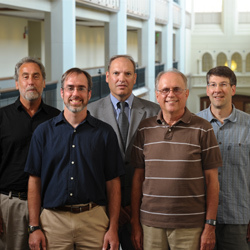

The high energy physics group at Notre Dame recently received a 3-year award from the National Science Foundation (NSF) to support their research with the Compact Muon Solenoid (CMS) detector at CERN, the European Organization for Nuclear Research. This new award began September 1, 2016, and will total $2.77 million for three years. The award represents a 15 percent increase over the group’s previous 3-year award of $2.4 million.
The group’s work includes physics analysis central to the Higgs boson discovery. “In high energy physics, our goal is to study and understand the fundamental constituents of matter and the forces that govern their interactions,” shared Mitch Wayne, a principal investigator in the group. “At the Large Hadron Collider located at CERN, circular beams of protons are collided together at very high energies. The collisions can produce all of the known elementary particles and hopefully some that we have not yet discovered. The CMS detector was designed and built to identify and measure the particles created in the collisions with great accuracy and precision.”
The five principal investigators for the grant are Mike Hildreth, Colin Jessop, Kevin Lannon, Randy Ruchti and Mitch Wayne. This NSF grant provides the base funding for the Notre Dame high energy physics group and it supports research faculty, postdoctoral fellows, graduate students, and much of the travel required to participate in an experiment located several thousand miles away.